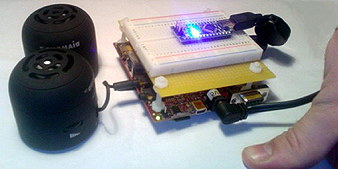Difference between revisions of "Satellite CCRMA To Do"
From CCRMA Wiki
| (4 intermediate revisions by the same user not shown) | |||
| Line 1: | Line 1: | ||
| + | [[Image:SatelliteLogo.png]] | ||
| + | |||
Post your detailed solution to one of these on the [http://groups.google.com/group/satelliteccrma Satellite CCRMA Google Group]. Remember, we will try to repeat your software solution later to incorporate it into the SD card release! | Post your detailed solution to one of these on the [http://groups.google.com/group/satelliteccrma Satellite CCRMA Google Group]. Remember, we will try to repeat your software solution later to incorporate it into the SD card release! | ||
| + | * Build a "how to"/lab on making an autonomous device combining power amp, battery, voltage regulator (yes capacitors with that!), audio starting on boot, and a button that causes the kit to be shut-down cleanly (see http://groups.google.com/group/satelliteccrma/browse_thread/thread/ea82ef0acd05224b) | ||
| − | |||
| + | * Benchmark Jacktrip performance more precisely. | ||
| − | |||
| + | * Document approaches for using a projector as a temporary display that doesn't draw much attention but could be used from time to time to change modes or adjust parameters. | ||
| − | |||
| + | * Get WiiMote/Cwiidtools working in pd under Ubuntu 10.10 on the xM board. | ||
| − | |||
| + | * Build some example (probably C++) programs that show how to call OpenGLES functions to get them to run natively on the graphics unit. In theory, this could off-load the graphics from the main CPU module, making it possible to do audio at the same time. (I suspect that the Quake demos are running on this same kind of computational unit.) | ||
| − | |||
| − | + | * Find out more about programming the C64x+ DSP using fixed-point or adapt similar for floating point. | |
| − | * | + | |
| Line 24: | Line 25: | ||
| − | * | + | * Work with Nando to link http://ccrma.stanford.edu/satellite and http://ccrma.stanford.edu/Satellite to http://ccrma.stanford.edu/~eberdahl/Satellite |
| − | * | + | * Verify that the StandardFirmata program is compatible with the kits. Then find a way to create a Linux script or program which, when executed, installs StandardFirmata onto the Arduino if it is not already installed. Maybe the avrdude command can be used. |
| − | + | ||
| − | + | ||
| − | + | ||
| − | + | ||
| − | + | <center> | |
| + | [[Image:BetaVersionSmall2.jpg]] | ||
| + | </center> | ||
Latest revision as of 00:39, 29 November 2011
Post your detailed solution to one of these on the Satellite CCRMA Google Group. Remember, we will try to repeat your software solution later to incorporate it into the SD card release!
- Build a "how to"/lab on making an autonomous device combining power amp, battery, voltage regulator (yes capacitors with that!), audio starting on boot, and a button that causes the kit to be shut-down cleanly (see http://groups.google.com/group/satelliteccrma/browse_thread/thread/ea82ef0acd05224b)
- Benchmark Jacktrip performance more precisely.
- Document approaches for using a projector as a temporary display that doesn't draw much attention but could be used from time to time to change modes or adjust parameters.
- Get WiiMote/Cwiidtools working in pd under Ubuntu 10.10 on the xM board.
- Build some example (probably C++) programs that show how to call OpenGLES functions to get them to run natively on the graphics unit. In theory, this could off-load the graphics from the main CPU module, making it possible to do audio at the same time. (I suspect that the Quake demos are running on this same kind of computational unit.)
- Find out more about programming the C64x+ DSP using fixed-point or adapt similar for floating point.
- Write a CCRMA Wiki describing how to prototype with the kit using only the most basic Linux commands. For this, we can assume that the user will never change directories—the user will always stay in the root ~ directory.
- Work with Nando to link http://ccrma.stanford.edu/satellite and http://ccrma.stanford.edu/Satellite to http://ccrma.stanford.edu/~eberdahl/Satellite
- Verify that the StandardFirmata program is compatible with the kits. Then find a way to create a Linux script or program which, when executed, installs StandardFirmata onto the Arduino if it is not already installed. Maybe the avrdude command can be used.

